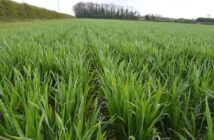Extreme diversity in the wheat yellow rust population has led to the introduction of a new naming system for races discovered in the UK.
A new race, announced by the UK Cereal Pathogen Virulence Survey (UKCPVS) in 2016, has been named ‘WYR Blue 7’ under the new system – replacing its provisional name ‘Invicta’.
The discovery of WYR Blue 7 in the UK is just one of several yellow rust population changes occurring during a period which also saw radical revisions to disease ratings in the AHDB Recommended List (RL) last autumn.
UKCPVS Stakeholder Event 2017
The new naming system was described at the annual UKCPVS Stakeholder Event, which took place on 8 March 2017 at the NIAB Innovation Farm in Cambridgeshire.
Dr Sarah Holdgate, UKCPVS project manager based at NIAB, said: “Last year was far from straightforward, from a yellow rust perspective. By mid-March 2016, we had received a record number of infected samples from wheat crops. It was a sign that something big was happening and the season ended with major revisions to RL ratings.
“Although we are still looking to pin down the race or races responsible for the breakdown, our monitoring has detected new races in the UK population and we are keeping an eye on them.”
The arrival of the Kranich race and a second new race was announced by the UKCPVS in 2016.
The second race, which was provisionally named ‘Invicta’, appeared similar to old UK isolates (such as the Solstice race), based on its ability to cause disease. Subsequent genotyping, however, showed that the race appeared more similar to the Warrior population.
Dr Holdgate continued: “Until now, naming a race based on the variety on which it was first detected has served us well.
“But the system no longer copes with the complex genotypic and pathology data we are seeing and we feel it is important to avoid using a variety’s name.”
WYR Blue 7 is the first name to be allocated to a race under the new system (which reflects a system used in potato blight virulence surveys) and replaces the provisional name ‘Invicta’.
2016 findings
A complete set of findings, based on 2016 isolate testing, was also presented at the event.
For wheat yellow rust, the Warrior race continues to dominate samples, with the Warrior 4 group found in at least half of samples tested by UKCPVS. After a period of decline, Warrior 1 increased in frequency in 2016. Virulence frequencies for most genes remained relatively stable in 2016. However, the YR7 gene was more prevalent, as was the YR8 gene (which is an indicator of the Kranich race), although it remains relatively rare.
For wheat brown rust, disease levels were relatively high in 2016 but no unexpected disease was reported to UKCPVS. Isolates have become more complex in recent years and investigations into the causal race associated with relatively high levels of brown rust in Crusoe continue.
For wheat and barley powdery mildews, virulence frequencies remain broadly similar to those seen in recent years.
Golden Jubilee
The monitoring of cereal pathogen populations has been coordinated in the UK since 1967.
To celebrate the golden anniversary, major population changes since recording began and the implications these changes had on plant breeding were also outlined at the event.
The event also included an update on pathogenomics, by the Earlham Institute’s Dr Diane Saunders, and a paper on the importance of disease surveillance to UK plant health, by Richard McIntosh, who is the Assistant Chief Plant Health Officer at Defra.
Get involved
Due to the diversity in UK pathogen populations, people are asked to monitor crops closely and to report unexpected findings to the UKCPVS. If you would like to get involved in the survey, sampling instructions are available from Amelia Hubbard. (amelia.hubbard@niab.com).
All presentations and reports can be downloaded from cereals.ahdb.org.uk/ukcpvs




